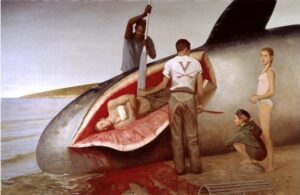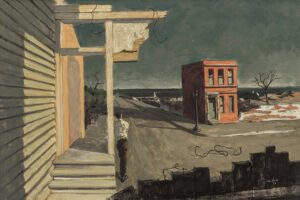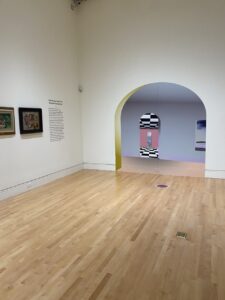Extra Ordinary: Magic, Mystery and Imagination in American Realism
Curated by: Jeffrey Richmond-Moll1
Exhibition schedule: Georgia Museum of Art, Athens, GA, February 27–June 13, 2021
Exhibition catalogue: Jeffrey Richmond-Moll, ed., Extra Ordinary: Magic, Mystery and Imagination in American Realism, exh. cat. Athens: Georgia Museum of Art, 2021. 252 pp.; illus. Cloth: $50.00 (ISBN: 0915977230)
Approaching the crest of the steps at the Georgia Museum of Art in Athens, Georgia, a massive painting by artist Bo Bartlett greets visitors. Separated from the main galleries of the exhibition, this work introduces the essential themes of “prophecy, parable, and performance” that figure prominently in Magic Realist paintings, in the words of the show’s curator, Jeffrey Richmond-Moll.2 Bartlett’s Leviathan (fig. 1) reimagines the biblical narrative of Jonah caught in the belly of a sea creature. Bartlett recasts the well-known religious story as a scene on the shores of a beach in the present day. The filleted whale is the backdrop of Bartlett’s family portrait: he is the primary figure inspecting the whale, flanked by his family members who are equally intrigued by the human body caught in the sea creature’s cavity. Leviathan foretells a future of ecological disaster, a concern that occupies the work of many of the artists in the exhibition. In his catalogue essay, Richmond-Moll notes that prophecy, parable, and performance function within Magic Realism to conjure a “world that parallels, exceeds, or complicates our own.”3 As the opening image in the visitor’s sightline, Leviathan prepares the viewer for the myriad ways in which artists producing work in the middle of the twentieth century sought to envision the world around them as a continuously morphing enigma. The powerful impact of Bartlett’s Leviathan grows as we consider our own emergence from the belly of a global pandemic while we seek to grapple with the mysticism and wonder in our everyday world.

Over the course of eight sections, Extra Ordinary: Magic, Mystery, and Imagination in American Realism offers a capacious survey of the trajectory of Magic Realism within American art. Building upon the 1943 exhibition American Realists and Magic Realists, which debuted at the Museum of Modern Art in New York, the Georgia show highlights the long-overshadowed tradition of Magic Realism in the United States. The group of artists practicing Magic Realism from the mid-1930s into the 1970s resisted the rising prevalence of pure abstraction. The artists chose realistic representation to fashion a fantastical visual language that investigates magic found in the everyday. While the show includes many of the works from the 1943 exhibition, Richmond-Moll decisively departs from the landmark exhibition to include works by women and people of color, destabilizing the white, male, New York–centered narrative that had been cemented into the canon of twentieth-century American art. By forcing Magic Realism out from the shadows of twentieth-century American art, the exhibition emphasizes the significance of the tradition as a means to grapple with “pressing contemporary issues, including war, race, class, and environment, and [allowing artists to] establish themselves, through a distinctly classical and historicizing style, within the history of art more broadly.”4 The artists sought to envisage a world plagued by war and environmental danger through the language of mystery and the fantastic, bursting through average scenes of daily life.
The exhibition opens with a room that includes a brief overview of American art in the twentieth century. Accented by a purple archway, the room also includes archival materials and art objects that sketch out the scope of the earlier exhibition that inspired Extra Ordinary. The introductory text specifically focuses on the tensions between realism and abstraction in modern art history that often resulted in a form of erasure of various strands of realism, including Magic Realism, from standard histories of American art and in a tendency of artists to reject a realist style. Thus the exhibit begins with a prelude to the aims of the project and the importance of revisiting the movement in the present day.
The second room of the exhibition includes two sections titled “Extra Ordinary: The Supernatural in the Everyday” and “Artistry, Illusion, Self-Representation.” Together, they foreground the mystery of the everyday, underscoring the blurred boundary between imagination and reality in the artists’ works. The first section focuses on the slippage between the mundane and the spectacular, most readily seen in John McCrady’s painting Swing Low, Sweet Chariot (1941). McCrady portrays a golden chariot chased by angels that descends on a desolate country farm. The heavenly chariot and the earthbound automobile in the foreground create a striking parallel between the celestial realm and the quotidian one below, visualizing the ways in which the supernatural seeps into the material world. The room’s second section moves the viewer from the magical landscapes of the physical world to the psychic internal landscapes of the artists themselves, including works by John Wilde and Brian Connelly that depict artists trapped in the wonderment of their own imagination. The artists featured in this section capture the self-referential capacity of Magic Realism. The works present images of the artists within their own compositions, hearkening back to Bartlett’s painting at the museum’s entrance. The selections also emphasize the potential of artists’ imaginations to create both psychic and material spaces.
The works in the next room are divided into four sections, separated by temporary walls, that probe the violence and mysticism that shape the world. Here, in the central gallery space, the viewer becomes aware of the slipperiness of the term “Magic Realism” and how the curator leans into its expansiveness rather than its limits. The section titled “Where the Past Meets the Future” focuses on artists whose work grapples with the challenges and mysteries of the passage of time. The section includes Hughie Lee-Smith’s enigmatic Contemplating My Future (1954; fig. 2), a bleak scene of urban decline punctuated by a sole figure leaning against a worn building post. Lee-Smith captures not only the ravages of time on our environment but also the sheer elusiveness that such changes pose on the human mind.5 The lone figure takes in the scene, caught on the threshold of what was and what could be. The section “Playful Fantasies” lays bare the fluidity of space and time as the artists depict the permeable boundary between interior and exterior, self and other, play and peril. Philip Evergood’s Sunday in Astoria (1935) depicts two women entangled around the body of a male figure cloaked in black, with children cavorting around them. The scene captures the chaos of people at play, grounded in a scene of everyday urban hustle and bustle. A boy playfully dangles a hat in front of a man, possibly instigating a game of keep-away. Their exuberance contrasts with a sense of looming danger brought on by the image of encroaching industrial advancement that is seen in a haze of polluting smog in the background.

On the other side of the gallery, the theme of imminent danger continues in the section titled “A World At War.” The constellation of works assembled here addresses the far-reaching implications of war, imperialism, and sexuality through the artists’ varied appropriations of the allegorical aspects of Magic Realism. The adjacent walls display works from the “Magic Realism as Social Commentary” section that examines the contours of the American social landscape, rife with poverty, racism, and other inequalities. In Laundress (1952), George Tooker portrays an intimate scene of an African American mother and three children gathered between the many sheets hanging in an alleyway. Two of the children directly confront the viewer, playing near their mother’s feet, while the other peers from behind her shoulder. The mother evokes the Virgin Mary, seated in three-quarter profile.6 The family’s slightly worn clothes reveal their economic position, but Tooker’s striking use of details and care in rendering the family’s individual features insists upon our reflection on the human condition that transcends race or class. Together, the four sections in this central gallery space emphasize the interesting and often tenuous dialectic between our inner and outer worlds.
The concluding sections of the exhibition—”Everything is Alive: The Magic Realist Still Life” and “A Living World: Magic Realism and Ecology”—explore the mystery of the world around us both in objects and in the natural environment. The former section includes trompe l’oeil paintings by Aaron Bohrod and Hananiah Harari. Here, the works present visual analogues of biocentrism prevalent in Magic Realist aesthetics and the wonderment of the connection between the human and nonhuman elements of the world. The latter section continues the theme of an animate natural world with works that investigate ecological disaster. It includes Archibald Motley Jr.’s Town of Hope (1927), an allegorical rendering of the Great Migration.7 The pendulous clouds in the hazy sky create an ominous mood that visualizes the connection between ecological and human conditions. Thus, the concluding section returns us to a view of the world that privileges the liminal space between abstraction and realism that births fantastical landscapes and enigmatic scenes rooted in the everyday. In sum, the exhibition showcases a neglected art style that portrays the potential of existing outside of the norm and resting in spaces of uncertainty that abound, nonetheless, with possibilities. In this manner, the artists in the exhibition underscore the importance of leaning into the mysteries of existence to better understand our everyday modern world.

Richmond-Moll utilizes the gallery space well, signaling thematic shifts with dynamic color and wall breaks (fig. 3) and crafting a narrative arc through excellent didactic texts that penetrate the opacity of some of the more enigmatic works. The pacing of the installation works well, with appropriate moments of pause for the viewer to take in groups of works before moving on to the next cluster. The inclusion of interactive elements through which viewers can place themselves within an optical illusion—a mural that makes the person appear to be in a room just beyond the gallery wall—allows the viewer to transcend the boundary of art and life, both underscoring one of the exhibition’s aims and enlivening the gallery space.
As a whole, the exhibition provides a solid, broad survey of the formal and conceptual work produced in the name of Magic Realism in the United States. However, as in any survey project, nuance and specificity often complicate the notion of implied comprehensiveness. At the outset, the show delineates its intervention as one that seeks to expand the definition and understanding of Magic Realism by bringing forth issues of gender, race, and sexuality. At times, it seems that these expansive conceptual aims overshadow the formal splendor of Magic Realism. In turn, the canon seems to widen, but it is still very much intact. This ambitious project shines light on a genre cast in the shadows of American art history, and it will hopefully lead to more exhibitions that interrogate the traditions and histories that deserve far greater critical attention.
March 11, 2022: An endnote was added to disclose Jeffrey Richmond-Moll’s affiliation with Panorama’s parent organization, the Association of Historians of American Art.
Cite this article: Kéla B. Jackson, review of Extra Ordinary: Magic, Mystery and Imagination in American Realism, Georgia Museum of Art, Panorama: Journal of the Association of Historians of American Art 7, no. 2 (Fall 2021), https://doi.org/10.24926/24716839.12757.
PDF: Jackson, review of Extra Ordinary
Notes
- Jeffrey Richmond-Moll is Co-Chair of Panorama’s parent organization, the Association of Historians of American Art ↵
- Jeffrey Richmond-Moll, “Extra Ordinary: Magic, Mystery, and Imagination in American Realism,” in Extra Ordinary: Magic, Mystery, and Imagination in American Realism, ed. Jeffrey Richmond-Moll (Athens: Georgia Museum of Art, 2021), 35. ↵
- Richmond-Moll, “Extra Ordinary,” 36. ↵
- Richmond-Moll, “Extra Ordinary,” 24. ↵
- Beth Hamilton, “The Mysteries of Hughie Lee-Smith’s Enigmatic ‘Contemplating My Future,’” Jonathan Boos gallery website, accessed July 22, 2021, https://jonathanboos.com/contemplating-my-future-hughie-lee-smith. ↵
- For more on George Tooker’s use of Christian iconography, see Kevin G. Grove, “George Tooker’s Altarpiece of Protest: Painting and American Loneliness,” Religion and the Arts 23, no. 5 (2019): 537–60. ↵
- The Great Migration dramatically shifted regional demographics in the United States, resulting in more than four million members of the African American population living outside of the South. Coming to prominence during the age of the Great Migration and the New Negro Movement, Archibald Motley’s work focuses on the various aesthetic struggles faced by African Americans using art to articulate their place as citizens. For more information on Motley, see Fionnghuala Sweeney, “Memory, Mobility, Modernity: Archibald Motley’s Portraits and the Art of ‘Serious Painting,’” Slavery and Abolition 34, no. 2 (2013): 236–51. On the Great Migration, see Stewart E. Tolnay, “The African American ‘Great Migration’ and Beyond,” Annual Review of Sociology 29, no.1 (2003): 209–32. ↵
About the Author(s): Kéla B. Jackson is a PhD candidate in the History of Art and Architecture at Harvard University

